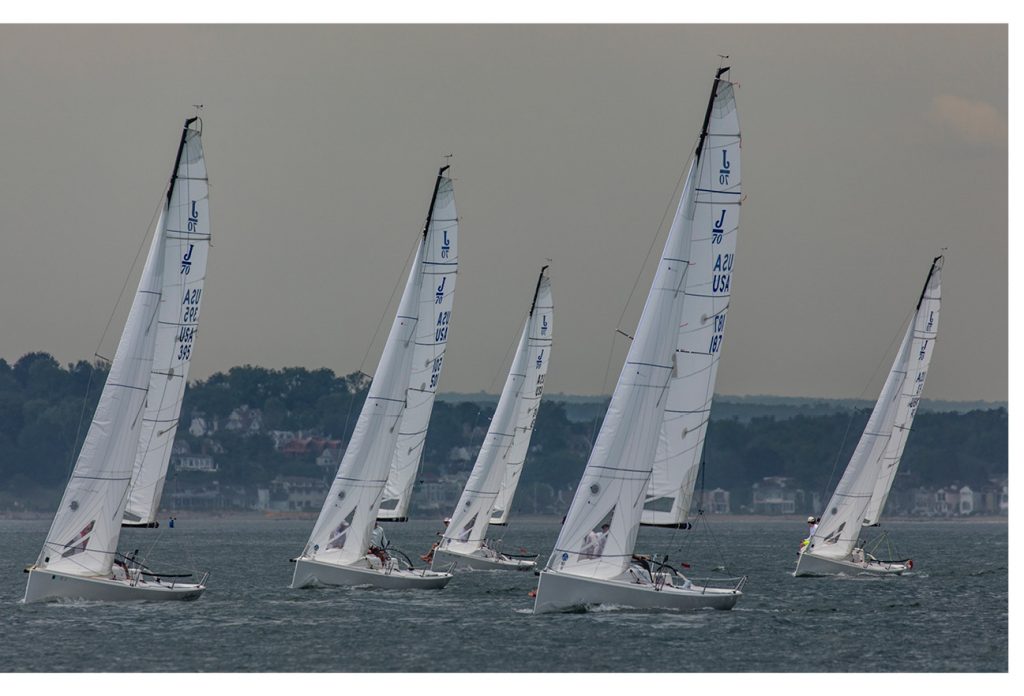In many races, changes in wind direction are the most common and significant strategic factor. The wind is almost always shifting, and even small changes in direction can lead to huge gains and losses in the race. Therefore, if you want to get to the first mark in good shape, you must be skilled at recognizing and playing the shifts.
In most races, the windshift pattern is either oscillating (i.e. shifting back and forth around a fairly steady average direction) or persistent (shifting steadily in one direction). Once in a while the wind is both oscillating and persistent, and very occasionally it is neither.
The best way to handle a persistent shift is exactly opposite to the strategy you’d use for a persistent shift. Therefore, it’s critically important to ask yourself (before the start and during the race) whether the shifts are oscillating or persistent.
Your answer will affect almost every aspect of your strategy and tactics on the first beat. And the correctness of your answer will probably have a large impact on your position at the windward mark. In order to figure out the windshift pattern, keep your head out of the boat.
When you’re not sure what the wind is doing, here are a few ideas. First, if you can figure out where the next shift is coming from, sail toward it, since this principle works for both oscillating and persistent breezes. Second, oscillating shifts are usually more common than persistent shifts. So if you’re in doubt, this is a good assumption to make. And finally, if you don’t know what the wind is doing, stay near the middle and keep your eyes open until you figure it out!

When the wind is shifting persistently, you’ll notice it first at one edge of the fleet. So keep your eyes on the boats that are farthest to each side. What you’ll see is a fanning effect as the shift spreads across the fleet. That is, the boats closest to the direction of the new shift will be sailing the highest angles, while the boats farthest from it are still sailing lower angles. © 2019 Stephen R Cloutier
How you can tell
Here are some clues you can use, both before and after the start of any race, to identify the wind shift pattern:
Oscillating shifts
You are more likely to have oscillating shifts when:
• The wind is blowing offshore.
• The wind on the water looks patchy or puffy.
• You have a gradient wind after passage of a cold front.
• Boats are lifted and headed on both sides of the course.
• Boats make gains (and losses) on both sides of the course.
• Headings on each tack go up and down within a range.
• The ‘favored’ end of the start line switches back and forth.
Persistent shifts
You are more likely to have a persistent shift when:
• The wind is blowing onshore.
• The wind on the water looks steady, or there’s an area of better pressure on one side.
• You have a thermal seabreeze.
• The farther you go to one side of the course, the more boats are lifted or headed.
• Boats on one side of the course always gain (or lose).
• Your headings on each tack trend in one direction.
• One end of the starting line gets more and more favored.
• The race committee has to move the windward mark for the second beat. ■
This article originally appeared in David Dellenbaugh’s Speed & Smarts, The newsletter of how-to tips for racing sailors. If you want to sail faster and smarter, log onto SpeedandSmarts.com.
A resident of Easton, CT, Dellenbaugh was tactician and starting helmsman for America3’s successful defense of the America’s Cup in 1992. He’s a Lightning World Champion, two-time Congressional Cup winner, seven-time Thistle National Champion, two-time winner of the Canada’s Cup, three-time Prince of Wales U.S. Match Racing Champion, and a winner of the U.S. Team Racing Championships for the Hinman Trophy.




